
Quercus muehlenbergii, the chinquapinoak, is a deciduous species of tree in the white oak group. The species was often called Quercus acuminata in older literature. Quercus muehlenbergii is native to eastern and central North America. It ranges from Vermont to Minnesota, south to the Florida panhandle, and west to New Mexico in the United States. In Canada it is only found in southern Ontario, and in Mexico it ranges from Coahuila south to Hidalgo.

Eacles imperialis, the imperial moth, is a member of the family Saturniidae and subfamily Ceratocampinae. It is found mainly in the East of South America and North America, from the center of Argentina to south Canada. The species was first described by Dru Drury in 1773.

Sphinx asellus, the asellus sphinx moth, is a moth of the family Sphingidae. The species was first described by Walter Rothschild and Karl Jordan in 1903. It is known from pinyon-juniper woodland and similar arid areas in the US states of Colorado, Nevada, Utah, extreme south-western Wyoming, Arizona, New Mexico and south-western Texas.
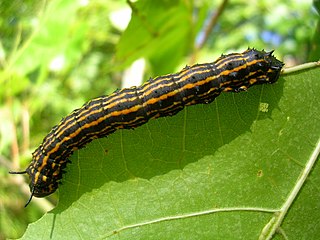
Anisota senatoria, the orangestriped oakworm, also known as the orange-tipped oakworm, is a Nearctic moth of the family Saturniidae and subfamily Ceratocampinae. It is one of the more common Saturniids, reaching pest status occasionally in the northern parts of its range. As they are late-season feeders, however, they do little lasting damage to their hosts. It is very similar to A. finlaysoni in southern Ontario and A. peigleri in the southern US. The species was first described by James Edward Smith in 1797.
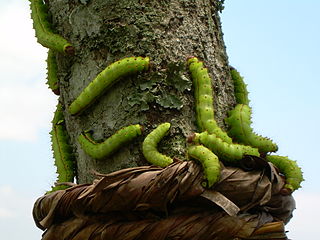
Wild silks have been known and used in many countries from early times, although the scale of production is far smaller than that from cultivated silkworms. Silk cocoons and nests often resemble paper or cloth, and their use has arisen independently in many societies.

Akbesia is a monotypic moth genus in the family Sphingidae erected by Walter Rothschild and Karl Jordan in 1903. Its only species, Akbesia davidi, the pistacia hawkmoth, was first described by Charles Oberthür in 1884. It is known from southern Turkey, northern Syria, northern Israel, western Jordan, south-eastern Turkey, north-eastern Iraq, south-eastern Georgia, northern Iran, eastern Afghanistan and Iranian Beluchistan. It may also occur across Azerbaijan, the Alborz Mountains of northern Iran, the Zagros Mountains of western and southern Iran, and northern Afghanistan. It often occurs in large numbers at certain sites in rocky, hilly areas supporting scattered trees and shrubs of Quercus, Olea, Ceratonia and Pistacia.
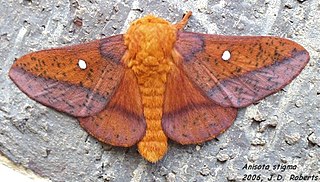
Anisota stigma, the spiny oakworm moth, is a moth of the family Saturniidae. The species was first described by Johan Christian Fabricius in 1775. It is found in North America from Massachusetts and southern Ontario to Florida, west to Minnesota, Kansas and Texas.

Eacles oslari, or Oslar's eacles, is a moth of the family Saturniidae. It is found from the Santa Rita, Patagonia, Atascosa and Huachuca mountains of southern Arizona south into Sonora, Sinaloa and Chihuahua in Mexico. Wings vary from yellow to purple brown. The species was first described by Walter Rothschild in 1907.

Mesogona olivata is a moth of the family Noctuidae. It is found from southern coastal and interior British Columbia south through California, Colorado and Texas. It most likely also occurs in northern Mexico.
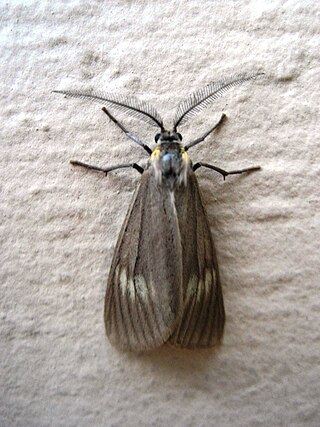
Phryganidia californica, the California oakworm or California oak moth, is a moth of the family Notodontidae. The species was first described by Alpheus Spring Packard in 1864. It is found along the coasts of the US states of California and Oregon.

Anisota virginiensis, the pink-striped oakworm moth, is a species of silk moth of the family Saturniidae.

Anisota is a genus of moths in the family Saturniidae first described by Jacob Hübner in 1820. Their caterpillars are known commonly as oakworms. They are defoliators of oaks.
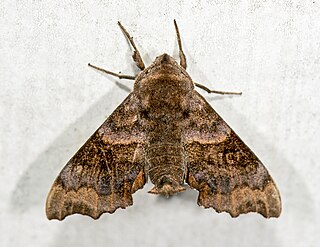
Cypoides chinensis is a species of moth of the family Sphingidae first described by Walter Rothschild and Karl Jordan in 1903.
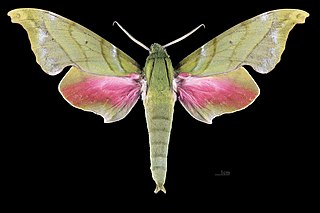
Rhodoprasina callantha, the small olive hawkmoth, is a species of moth of the family Sphingidae. It is found from north-eastern India across south-western China and northern Thailand to northern Vietnam.
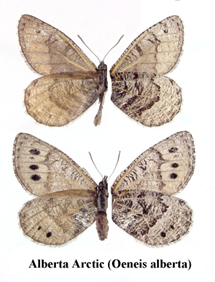
Oeneis alberta, the Alberta Arctic, is a butterfly of the family Nymphalidae. It is found from the Canadian prairie provinces east to southern Manitoba. Isolated populations are found along the Rocky Mountains in Colorado, New Mexico and Arizona.

Amblyscirtes oslari, the Oslar's roadside skipper, is a butterfly of the family Hesperiidae. It is found in North America from southern Alberta, Saskatchewan, and North Dakota south through the high plains and Rocky Mountains to Arizona, New Mexico, and south Texas.
Satyrium polingi, or Poling's hairstreak, is a butterfly of the family Lycaenidae. It was described by William Barnes and Foster Hendrickson Benjamin in 1926. It is found in North America from southern New Mexico and western Texas south to north-eastern Mexico. The habitat consists of oak woodlands.
Pseudohemihyalea labecula, the freckled glassy-wing, is a moth in the family Erebidae. It was described by Augustus Radcliffe Grote in 1881. It is found in the United States in southern Nevada, Utah, from Colorado to Arizona, New Mexico and western Texas.
Anisota manitobensis, the Manitoba oakworm moth, is a species of royal moth in the family Saturniidae. It is found in North America, primarily Manitoba.
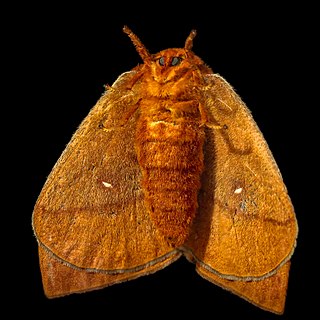
Anisota consularis, the Florida oakworm moth or consular oakworm moth, is a moth in the family Saturniidae. The species was first described by Harrison Gray Dyar Jr. in 1896. It is found in North America.
















